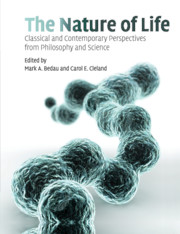Book contents
- Frontmatter
- Contents
- Preface
- Acknowledgments
- Sources
- About the authors
- Introduction
- SECTION I CLASSICAL DISCUSSIONS OF LIFE
- SECTION II THE ORIGIN AND EXTENT OF NATURAL LIFE
- 8 The origin of life: a review of facts and speculation
- 9 Small molecule interactions were central to the origin of life
- 10 Are the different hypotheses on the emergence of life as different as they seem?
- 11 The universal nature of biochemistry
- 12 Is there a common chemical model for life in the universe?
- 13 Searching for life in the universe: lessons from Earth
- 14 The possibility of alternative microbial life on Earth
- 15 Introduction to the limits of organic life in planetary systems
- SECTION III ARTIFICIAL LIFE AND SYNTHETIC BIOLOGY
- SECTION IV DEFINING AND EXPLAINING LIFE
- Supplementary bibliography on life
- Index
- References
11 - The universal nature of biochemistry
Published online by Cambridge University Press: 10 November 2010
- Frontmatter
- Contents
- Preface
- Acknowledgments
- Sources
- About the authors
- Introduction
- SECTION I CLASSICAL DISCUSSIONS OF LIFE
- SECTION II THE ORIGIN AND EXTENT OF NATURAL LIFE
- 8 The origin of life: a review of facts and speculation
- 9 Small molecule interactions were central to the origin of life
- 10 Are the different hypotheses on the emergence of life as different as they seem?
- 11 The universal nature of biochemistry
- 12 Is there a common chemical model for life in the universe?
- 13 Searching for life in the universe: lessons from Earth
- 14 The possibility of alternative microbial life on Earth
- 15 Introduction to the limits of organic life in planetary systems
- SECTION III ARTIFICIAL LIFE AND SYNTHETIC BIOLOGY
- SECTION IV DEFINING AND EXPLAINING LIFE
- Supplementary bibliography on life
- Index
- References
Summary
People have long speculated about the possibility of life in settings other than Earth. Only in the past few centuries, however, have we been able to conceive of the specific nature of such settings: other planets around our own Sun and solar systems similar to our own elsewhere in the physical universe. Speculation on the nature of life elsewhere often has paid little heed to constraints imposed by the nature of biochemistry, however. A century of fanciful science fiction has resulted not only in social enthusiasm for the quest for extraterrestrial life, but also in fanciful notions of the chemical and physical forms that life can take, what the nature of life can be. Since the time of the Viking missions to Mars, in the mid-1970s, our view of life's diversity on Earth has expanded significantly, and we have a better understanding of the extreme conditions that limit life. Consequently, our search for extant life elsewhere in the solar system can now be conducted with broader perspective than before.
How can life be detected regardless of its nature and origin? Considering the recent spectacular advances in observational astronomy, it seems likely that the first sign of life elsewhere will be the spectroscopic detection of co-occurring non-equilibrium gases, for instance oxygen and methane, in the atmosphere of a planet around some distant star. Co-occurrence of such gases would indicate that they are replenished, perhaps most readily explained by the influence of life.
- Type
- Chapter
- Information
- The Nature of LifeClassical and Contemporary Perspectives from Philosophy and Science, pp. 157 - 163Publisher: Cambridge University PressPrint publication year: 2010
References
- 2
- Cited by



